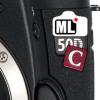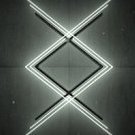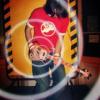Leaderboard
Popular Content
Showing content with the highest reputation on 04/24/2013 in all areas
-
GH2 sensor goes into impressive Panasonic G6, adds 1080/60p and focus peaking!
Sean Cunningham and one other reacted to andy lee for a topic
this camera keeps the legacy of the gh2 moving forward for a few more years Im very pleased this G6 has been released - Panasonic are listening that we all say the gh2 sensor has some special magic about it!2 points -
Eagerly awaiting your Pocket Cinema Camera? You already have a micro for thirds camera and some C-mount lenses? Want to know if they will cover the sensor of the Pocket? Lets find out! I hope you will add your results, so we can make this list growing. I will only add lenses to the lists when you have proof, in other words: images. How? Because we know the active sensor area of the BMPCC measures 12,48 x 7,02 mm, it is fairly easy to check if our C-mount lenses will cover the full sensor. Calculate this by taking a picture with a lens on your micro four thirds camera, and crop out the image area of theBMPCC. In Photoshop: Open the image. Go to Edit > Image Size, uncheck resample image. Change Image width to 19 centimeters, press ok Go to Image > Canvas Size, change dimensions to 12,48 x 7,02cm, press OK to crop the image to BMPCC size. Resize to 1920x1080 pixels Post your results! Note: If you shoot on the GH3 or other MFT camera's, the sensor size is 17 x 13mm, so change the width in step 3 to 17 cm! To lazy to do it yourself or you can't work it out? Upload the full resolution files and I'll do it. List terms explained: Yes = covers the full sensor of the Blackmagic Pocket Cinema Camera No = doesn't cover the sensor Needs modification = Doesn't fit on C-mount to M43-adapter without modifications Equivalent = The focal length and depth equivalent on a fullframe camera (5D Mark III for example) Blackmagic Pocket Cinema Camera Compatibility list Primes Apollo 25mm f/0.85 - Yes = 72mm f/2.4 equivalent [link to proof] Angenieux 10mm f/1.8 Retrofocus (Fixed Focus) - Yes (dark corners) = 28,8mm f/5.2 equivalent [link to proof] [more info] Carl Zeiss Jena Tevidon 10mm f/2 - Yes - Needs modification = 28,8mm f/5.8 equivalent [link to proof] [more info] Carl Zeiss Jena Tevidon 35mm f/1.9 - Yes - Needs modification = 101mm f/5.6 equivalent [link to proof] Century 9mm f/1.8 - YES (poor quality) [link to proof] Computar 8mm f/1.3 - NO [link to proof] Computar 16mm f/1.4 - NO [link to proof] Computar TV Lens 25mm f/1.8 - YES = 72mm f/5,2 equivalent [link to proof] Cosmicar 8,5mm f/1.5 - NO [link to proof] Cosmicar 12.5mm f/1.8 - YES - Needs modification = 36mm f/5.2 equivalent [link to proof] Cosmicar 25mm f/1.8 - YES - 72mm f/5.2 equivalent [link to proof] Ernitec 6.5mm f/1.8 - YES (heavy distortion) [link to proof] Ernitec/Navitar 17mm f/0.95 - YES (v. blurry corners & distortion) [link to proof] Fujinon TV 12.5mm f/1.4 - Yes (blurry corners) - Mod.? (unknown) = 36mm f/4 equivalent [link to proof] Fujinon TV 16mm f/1.4 - NO [link to proof] Fujinon TV 35mm f/1.7 - YES - Needs modification = 101mm f/4.9 equivalent [link to proof] Leitz Macro Cinegon 10mm f/1.8 - Yes (dark corners) = 28,8mm f/5.2 equivalent [link to proof] Kern Switar 10mm f/1.6 - Yes (slight vignette & blurry corners) [link to proof] Nikon Cine Nikkor 13mm f/1.8 - Yes = 37,5mm f/5.2 [link to proof] Nikon Cine Nikkor 25mm f/1.8 - Yes = 72mm f/5.2 equivalent [link to proof] Pentax 25mm f/1.4 - YES - 72mm f/4 equivalent [link to proof] Schneider 10mm f/1.8 (silver version) - No (almost) [link to proof] Schneider-Kreuznach Cinegon 11.5mm f/1.9 - No (almost) = 33mm f/5.6 equivalent [link to proof] Schneider-Kreuznach Cine-Xenon 16mm f/2 - Yes = 46mm f/5.8 equivalent [link to proof] [link to proof (2)] Schneider-Kreuznach Xenon 25mm f/0.95 - Yes = 72mm f/2.7 equivalent [link to proof] Schneider Xenoplan 17mm f/1.7 - Yes (blurry corners) - [link to proof] SLR Magic 11mm F1.4 - Yes - [link to proof] (added by EOSHD) Tokina TV Lens 8mm f/1.3 - NO [link to proof] Tokina TV Lens 16mm f/1.6 - NO [link to proof] Taylor-Hobson Cooke Kinic 25mm f/1.3 - Yes = 72mm f/3.7 equivalent [link to proof] Taylor-Hobson 25mm f/1.9 - Yes - 72mm f/5.6 equivalent [link to proof] Wesley 25mm f/1.4 - YES = 72mm f/4 equivalent [link to proof] Wollensak Cine Raptar 12.5mm f/1.5 - Yes = 36mm f/4.3 equivalent [link to proof] Wollensak Cine Raptar 25mm f/1.9 - Yes = 72mm f/5.6 equivalent [link to proof] $ 25 noname 25mm f/1.2 CCTV - YES = 72mm f/3.5 equivalent [link to proof] Zooms Ernitec 6-12mm f/1.4 - NO [link to proof] Kowa TV Zoom 12.5-75mm f/1.8 - NO [link to proof]1 point
-

Holymanta - the ND filter lens adapter
Ratguity reacted to Andrew Reid for a topic
[media]http://vimeo.com/63910035[/media] First 1.50 minutes is sample footage, you can fast forward to 1.50 for the technical info This is something I've wanted for a long time! Focus and exposure are the most important things on a movie camera yet DSLRs don't have a built in ND filter and you're often left to shoot at ugly high shutter speeds such as 1/1000 in bright light to control exposure. With this adapter you can add a variable ND filter wheel to any mirrorless mount camera (E-mount, Micro Four Thirds) effectively adding the main ergonomics advantage of the Cinema EOS C300 and Panasonic AF100. [url=http://www.eoshd.com/content/10149/holymanta-the-nd-filter-lens-adapter]Read the full article here[/url]1 point -
Some of the cons pointed out for Blackmagic Camera come from the point of view of casual DSLR shooting, not compared to other cinema cameras, which is what it's intended to compete with in a more budget-conscious manner. This was my thinking when pre-ordering the new Quad HD model. A practical example: The other day we were shooting an internal film for a client on Alexa Plus 4:3. Hey, if they can afford it... The camera weighs 7KG (15lbs), that's just the body. Then you hang a Cooke prime on the front, a pair of Anton Bauers on the back and that's up to 10kg (22lbs) or so. Swap that for an Angeniuex or Arri Allura zoom for exmaple and you're up to 13KG (28lbs). That's before rigging, which needs to be heavy duty enough to hold such weight. As does your tripod. We ate through eight big batteries in one day shoot, and they are bloody big expensive batteries. Also it wasn't really a full day in shoot terms. For day two we went to a an external tethered battery that was like a massive block of lead, so you have a person carrying that behind. Does it look beautiful? Hell yeah! But it's not very easy... The 4K (or Quad HD) BMD has an S35 sensor (it's actually smaller than S35 as most would think of it, but not enough to bother with, and not much more than the F55) and you should be able to power it for a long time off of a chunky V-lok on a rig. You can then downscale the image in post or in camera to HD. You lose a few stops to the Alexa, but you can buy it for the price of a few days Alexa hire and use it every day til you know it like the back of your hand and you fill up your hard drive. And you can actually run and gun relatively stealthily due to global shutter and light weight. Seeing what could be done with the previous model of cinema camera actually made me think it wouldn't cut to bad with the Arri either. Compared to picking up a 550D and shooting a friend or the trees outside, sure, Blackmagic cameras seem annoying, but compared to setting up a cinema camera? All the evidence so far from their previous camera suggests you'll get a long way to the wonderful look for less money, weight and hassle. Same for the pocket version, even if you have to rig it for batteries for some projects, I mean look at it, it's the size of a f***ing phone! If you want to make narrative drama or blocked-out promo that is an amazing thought... you don't need to budget in a load of camera hire... just buy one of these, and that's all your films for the next three years sorted. Now the new Red may have 6K, but I can't remember looking at a film shot on the old Red and thinking "oh that's not very detailed", quite the opposite, so it's quite excessive right now, and the cost is so high. Let's just hope the new Cinema Cameras turn up in good time with no issues, after last year's debacle, all of those who have pre-ordered are rather nervous. There's quite a bit riding on these two models... Now I just have to have a good idea... I knew there was a catch... ;)1 point
-
I understand YouTube compression and those videos' softness has nothing to do with it (though I deeply wish it did). That can only come from either a bad encoding on the uploader's side or indeed the camera's true capabilities. Watch any good GH2 video uploaded to YouTube and you'll see there's no such softness in them, in spite of YouTube's compression. Here's one, for instance: http://www.youtube.com/watch?v=rcKuGoMN-VQ Still, I'm rooting for this camera to be what all of us are hoping.1 point
-
you are watchin on youtube - mega compressed so beware...- lets not write it off before we have all downloaded files direct off the camera, If it has Venus engine inside then its hackable....its been done before by Vitaliy and Driftwood etc1 point
-

Widest lens for Pocket Blackmagic camera Bolex anamorphot?
Tito Ferradans reacted to septemberdawn for a topic
The 8/19/1.5x has a 39mm front filter thread.1 point -

'Oblivion' Front Projection in Hollywood films
HurtinMinorKey reacted to Husah for a topic
https://vimeo.com/637527411 point -

Blackmagic Pocket Cinema Camera c-mount lens compatibility list
Mirrorkisser reacted to pulp_writer for a topic
Hello Julian, great idea, very informative! For all those who would like to try some old lenses on the BMPCC, here are my lenses between 10 and 16 mm. None of these is younger than 30 years, most are cine-lenses taken from 8mm or 16mm cameras. Some can still be found cheap on eBay, others have multiplied in price since I bought them. All show vignetting with the MFT sensor, so I had virtually given up on them (except in crop mode). This first batch of images is with the apertures open. I will upload some shots from outdoors with apertures stopped down later. Leitz Macro Cinegon 10mm f/1.8 This is actually not a C but an M-mount lens, made for Leica’s flagship super 8 camera, the Leicina Special in the 1970s. Very attractive because it has a macro mode. It shows very slight vignetting, but may be usable still. Schneider-Kreuznach Cinegon 11.5mm f/1.9 A very popular lens for 8 and 16mm (1960s~). Also shows vignetting, but doesn't look too bad. Wollensak Cine Raptar 12.5mm f/1.5 A very old lens from an ancient 16mm Bell & Howell Filmo 70 DA, manufactured in the1930s. This is a f/1.5 lens but is a little soft wide open, so I stopped it down to f/2.7. Shows no vignetting. Cine-Nikkor 13mm f/1.8 This one comes from a very rare Japan Victor Corporation 16mm camera made in 1957. Nikon used to make very good cine lenses. This one is wide open now, but gets sharper when stopped down. (It looks like a wider lens here compared to the others, but that's only because I had to move back a little with my tripod to get it to focus.) No vignetting. Schneider-Kreuznach Cine-Xenon 16mm f/2 From a Beaulieu RC16, 1960s. Unfortunately, there's something wrong with the aperture ring of this one: it won't move. But still, a very fine lens without vignetting. (Well, looking at the thumbnail, you can see that the lower left corner is considerably darker. But in the full picture, it is not that apparent) I have two more lenses in this category, one is a Canon TV Zoom 11-110mm, which I didn't put on because it only focuses to 1.2m, and the other is an Angenieux 10mm Retrofocus lens, which is totally out of focus when wide open. I have also found an Avenir CCTV lens 6.5mm, very wide, which looks promising, but it is a fixed focus lens too. I will put them on along with the others when I shoot outside.1 point -

'Oblivion' Front Projection in Hollywood films
HurtinMinorKey reacted to Hans Punk for a topic
Bet they hooked up an Xbox when the Cruise was not around.1 point -
I think you have to decide for yourself what is most important. Image Quality: BMPCC probably wins big time with the dynamic range and the raw editing options - But the GH3 is still very good Ease of use: GH3 - Flip-screen, oled viewfinder, lots of buttons, touch screen. Reasonable file sizes Lens flexibility: Both pretty flexible, GH3 wins because finding good wide angles or bright standard lenses for the BMPCC is going to be more difficult (and expensive) with the 3x cropfactor. The GH3 is a much more complete camera than the BMPCC. The Pocket is just the cheapest way to get raw footage.1 point



